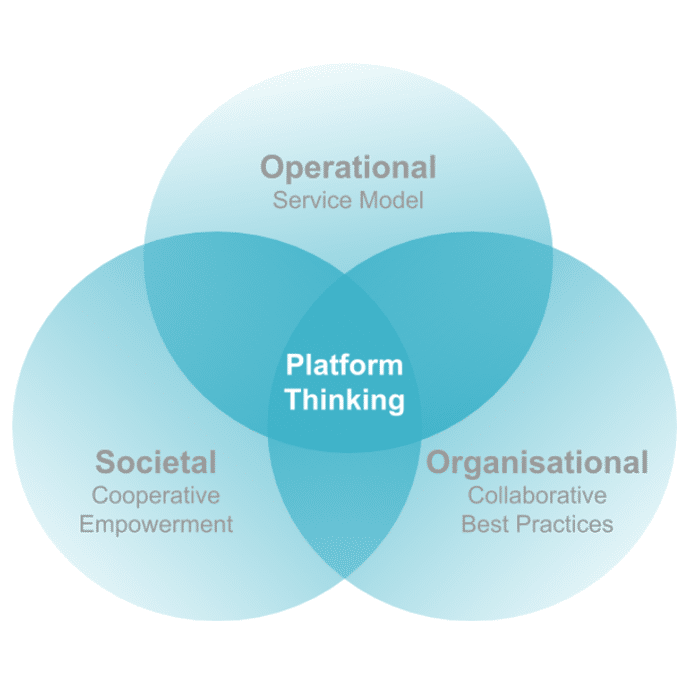
What is Platform Thinking?
Table of contents
Platform Thinking is part of the realization that consumers are no longer passive participants in the product lifecycle. They are actively engaging in the value creation cycle. And leveraging that outsourced value creation is as crucial to product development as any other aspect of PLM.
What is a Platform?
A platform should act as a centralizing hub for your business
Industry experts have attached the term “platform” to products, infrastructures, business models, software, ecosystems and much more besides. In fact, the conversation around platform thinking has continued for more than a decade. But throughout this debate, the key principle that ties these concepts together is that platforms build a network of communication between users and developers to provide shared benefit. In other words, platforms are designed to foster innovation by creating an empowered, collaborative network of peers.

What Are Software Platforms?
A platform should bring together people, processes and data
A platform enables growth through connections to tools, people, processes and data. But, how is that different to a suite of software? Well, a software suite provides a pre-packaged, or out-of-the-box, set of applications to tackle a specific set of tasks. But a software platform provides options. You might only need some of those applications to begin with, but you’ll know that you have the option to expand into other areas when the need arises.
Software platforms may even provide the option to connect with entire software suites. For instance, PLM platforms provide solutions for an array of disciplines – Engineering and Design, Manufacturing, Simulation and more. And, as each of these areas encompass various specialisms, it makes sense to provide specialist software tools for them.
What is a PLM Platform?
Information management that propels innovation
Firstly, what is Product Lifecycle Management? PLM is a holistic approach to product development. It an organizational directive that incorporates every aspect of a product’s lifecycle. And it’s much more than simply software. But a PLM platform is the foundation that connects every tool, application and software necessary for your organization to take a product from ideation to creation and beyond.
PLM platforms provide you with the freedom and support to expand.
So, a PLM platform may connect Computer-Aided Design (CAD) software suites such as CATIA or SOLIDWORKS with Computer-Aided Manufacturing (CAM) software suites such as DELMIA. This means that every speck of data concerning your product is communicated live from a single source of truth.
Every team member, wherever they are, has access to the same data and they’re able to update, revise and discuss that data in real time. So, Product Lifecycle Management (PLM) platforms provide a cohesive ecosystem in which your organisation, culture and business model can collaborate efficiently and thrive.
Building Better Businesses Within a Platform Ecosystem
How Does Platform Thinking Shape Product Development?
The term “platform ecosystem” is used to refer to the applications, tools and software available for use in conjunction with a digital platform. This may refer to products developed and managed by the platform provider, or by developers working alongside them. For example, TECHNIA Software’s Experience Packaged suite is part of the 3DEXPERIENCE platform ecosystem – these are tools and applications which complement the 3DEXPERIENCE platform.
Here, you can access a recent presentation from Gian Paolo Bassi, CEO SOLIDWORKS discussing “How Platform Thinking Can Transform Businesses“.
Manufacturers benefit from working within a PLM platform ecosystem in many ways. These vary from industry to industry. But there are three key reasons that PLM platform implementations can benefit any organization.
Firstly, PLM platforms bring together people, processes and data. Meaning that your organizational Intellectual Property (IP) is centralized, and readily available to all permissible users at any given time. This ensures that all communication and action concerning your product is as relevant and efficient as possible.
Secondly, investing in a PLM platform ecosystem enables you to expand or streamline areas of your organization as you require. This is made more easily attainable with PLM platforms on Cloud – as application licenses can be made available according to, and on demand.
Thirdly, working within a common PLM platform enables simple supplier collaboration. this means that your suppliers can be granted access to relevant, live data just as easily as your own teams can. Simply put, you’re sharing the benefits of your PLM platform with the organizations you work with.
In Our Experience…
Platform Thinking is changing the way the markets perform, and the way that businesses grow. But, one thing will never change – innovation and problem-solving.
What’s most important for your business is the ability to solve your customers’ problems in newly improved, innovate ways. To do this while meeting regulatory and compliancy demands. To maintain the pace of production in accelerating markets. And to do all of this while improving your profit margins.
PLM platforms are here to help you do all of that.
